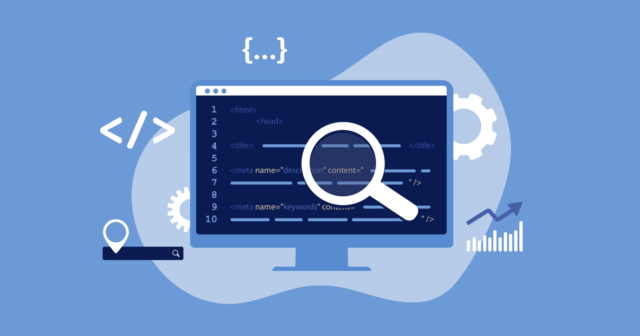When it comes to search engine optimization (SEO), meta tags play a crucial role in helping search engines understand the content of your web pages. They are essential components that can significantly impact your website’s visibility in search engine results pages (SERPs). In this blog, we’ll discuss how to optimize your website’s meta tags effectively to improve your SEO and drive more traffic to your site.

Table of Contents
ToggleWhat Are Meta Tags?
Meta tags are snippets of text that describe a webpage’s content. They do not appear on the actual page but are embedded in the HTML of the webpage. The most common types of meta tags include:
- Title Tag: The title of the page that appears in the browser tab and in search engine results.
- Meta Description: A brief summary of the webpage content that appears below the title in SERPs.
- Meta Keywords: A set of keywords relevant to the page (note: this tag is largely outdated and not used by most search engines).
- Robots Meta Tag: Instructions for search engine crawlers on how to index the page.
Why Are Meta Tags Important for SEO?
- Improved Click-Through Rates (CTR): Well-optimized title tags and meta descriptions can entice users to click on your link instead of others in the search results.
- Search Engine Understanding: Meta tags help search engines comprehend the content of your pages, influencing how they rank your site.
- User Experience: Accurate and informative meta tags provide users with a clear idea of what to expect on your page, enhancing their overall experience.
How to Optimize Your Meta Tags for Better SEO
1. Optimize Your Title Tags
The title tag is one of the most critical on-page SEO elements. Here’s how to optimize it effectively:
- Include Target Keywords: Place your primary keyword at the beginning of the title tag. This helps search engines and users understand the focus of your page.
- Keep It Concise: Aim for a length of 50-60 characters to ensure the entire title displays in search results. Longer titles may get cut off, losing important information.
- Make It Compelling: Use action-oriented language to encourage clicks. Phrasing like “Discover,” “Learn,” or “Get” can create a sense of urgency.
- Branding: If applicable, include your brand name at the end of the title tag to enhance brand recognition.
2. Craft Engaging Meta Descriptions
A well-written meta description can significantly impact your click-through rate. Here are some tips for optimizing it:
- Summarize the Content: Clearly describe what users can expect to find on the page. Aim for a length of 150-160 characters to ensure it displays correctly in search results.
- Include Keywords: Incorporate relevant keywords naturally, as search engines may bold these terms when users search for them.
- Create a Call to Action: Encourage users to take action with phrases like “Read more,” “Shop now,” or “Get started today.”
- Be Unique: Each page on your website should have a unique meta description to avoid duplication and to better reflect the content of each page.
3. Use Header Tags Strategically
While header tags (H1, H2, H3, etc.) are not traditional meta tags, they play a crucial role in SEO and user experience:
- H1 Tag: Ensure that your H1 tag includes your primary keyword and summarizes the page content. Each page should only have one H1 tag.
- H2 and H3 Tags: Use H2 and H3 tags for subheadings to organize content logically. This helps both users and search engines understand the structure of your content.
4. Implement Robots Meta Tags
Robots meta tags provide instructions to search engine crawlers. Here’s how to use them:
- Control Indexing: Use the “noindex” directive if you don’t want a page to be indexed by search engines (e.g., for duplicate content or low-value pages).
- Control Following: Use the “nofollow” directive to prevent search engines from following links on a particular page.
- Use with Caution: Be mindful when using these tags, as improper use can hinder your site’s visibility in search results.
5. Monitor and Update Regularly
SEO is not a one-time effort; it requires ongoing monitoring and updates:
- Use SEO Tools: Tools like Google Search Console, Ahrefs, and SEMrush can help you analyze your meta tags’ performance and identify areas for improvement.
- A/B Testing: Experiment with different title tags and meta descriptions to see which versions yield the best click-through rates.
- Stay Updated: Keep abreast of SEO best practices and algorithm updates, as they can influence how search engines interpret meta tags.
6. Avoid Keyword Stuffing
While including keywords is essential, it’s crucial to avoid keyword stuffing, which can lead to penalties from search engines. Ensure that your title tags and meta descriptions flow naturally and are written for users, not just for search engines.
Conclusion
Optimizing your website’s meta tags is a vital step in improving your SEO efforts and increasing your online visibility. By crafting compelling title tags and meta descriptions, strategically using header tags, implementing robots meta tags, and monitoring your performance, you can enhance your website’s chances of ranking higher in search results. Remember, the goal is to provide a clear and enticing summary of your content that attracts users while satisfying search engine requirements. Start optimizing your meta tags today, and watch your website traffic grow!


No responses yet